CHEVROLET MALIBU 1998 Owners Manual
Manufacturer: CHEVROLET, Model Year: 1998, Model line: MALIBU, Model: CHEVROLET MALIBU 1998Pages: 362, PDF Size: 19.35 MB
Page 321 of 362
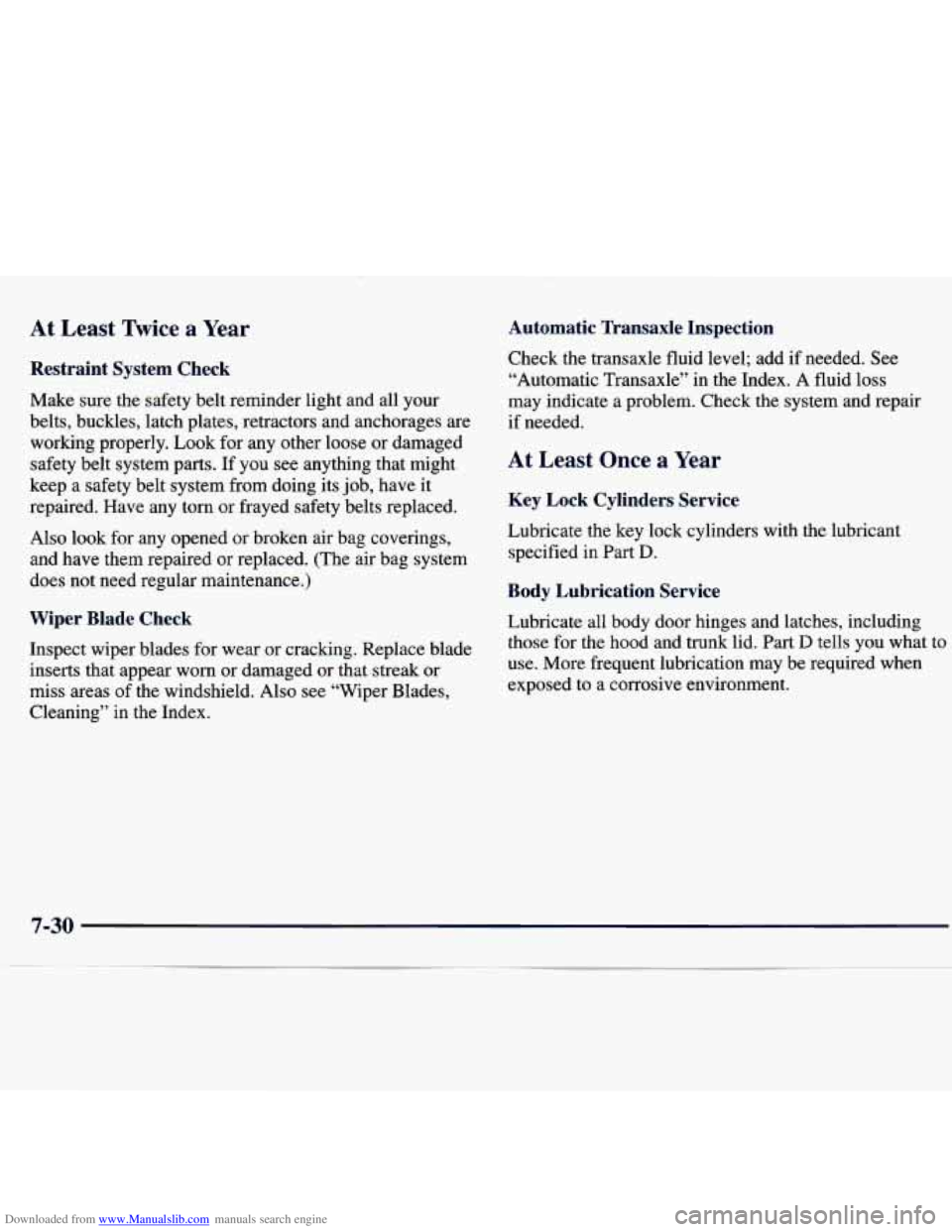
Downloaded from www.Manualslib.com manuals search engine At Least Twice a Year
Restraint System Check
Make sure the safety belt reminder light and all your
belts, buckles, latch plates, retractors and anchorages are
working properly. Look for any other loose
or damaged
safety belt system parts. If you see anything that might
keep a safety belt system from doing its job, have it
repaired. Have any torn or frayed safety belts replaced.
Also look for any opened or broken air bag coverings,
and have them repaired or replaced. (The air bag system
does not need regular maintenance.)
Wiper Blade Check
Inspect wiper blades for wear or cracking. Replace blade
inserts that appear worn or damaged
or that streak or
miss areas
of the windshield. Also see “Wiper Blades,
Cleaning’’ in the Index.
Automatic Transaxle Inspection
Check the transaxle fluid level; add if needed. See
“Automatic Transaxle” in the Index.
A fluid loss
may indicate a problem. Check the system and repair
if needed.
At Least Once a Year
Key Lock Cylinders Service
Lubricate the key lock cylinders with the lubricant
specified in Part
D.
Body Lubrication Service
Lubricate all body door hinges and latches, including
those for the hood and trunk lid.
Part D tells you what to
use. More frequent lubrication may be required when
exposed to a corrosive environment.
7-30
Page 322 of 362
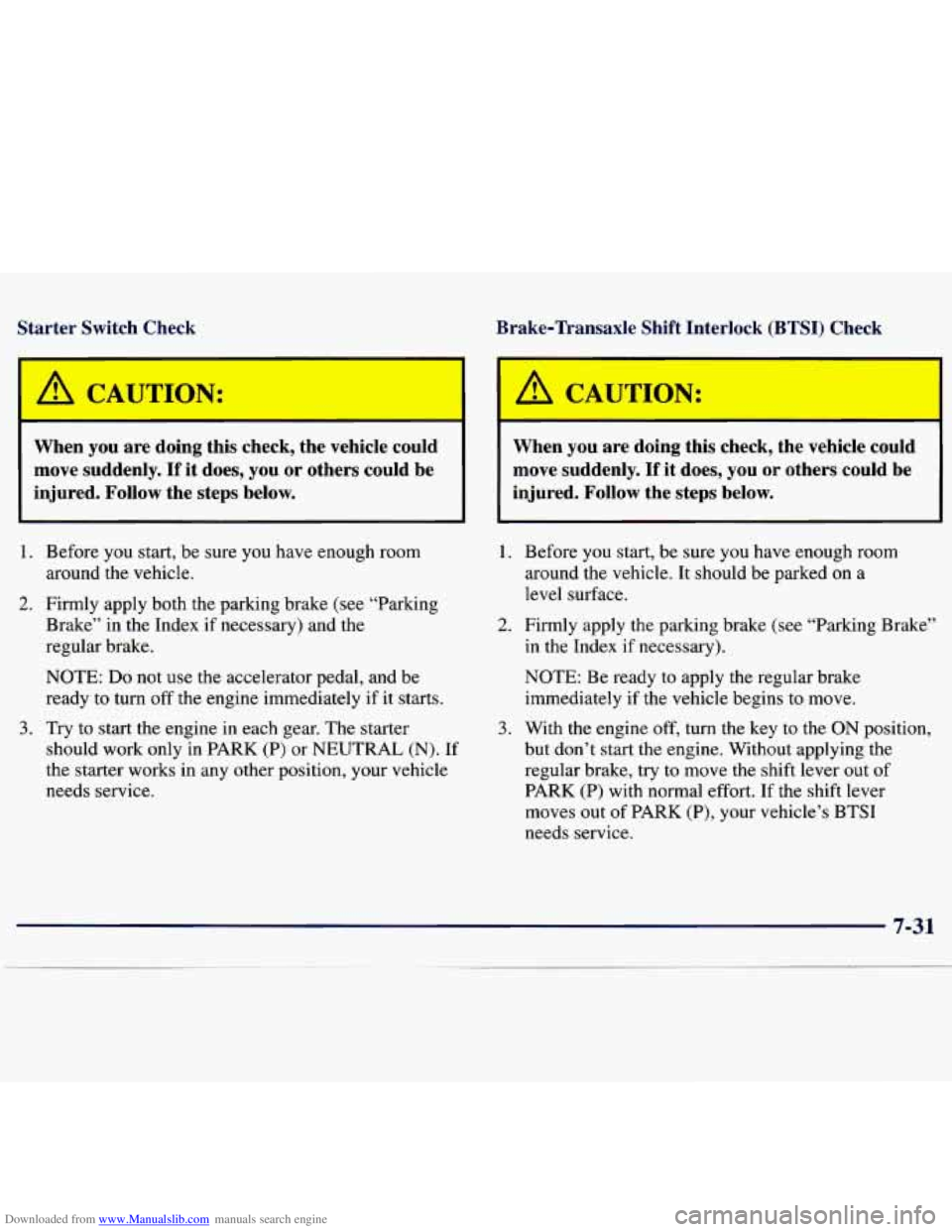
Downloaded from www.Manualslib.com manuals search engine Brake-Transaxle Shift Interlock (BTSI) Check
Starter Switcr :heck
I CAUTION:
When you are doing this check, the vehicle could
move suddenly. If
it does, you or others could be
injured. Follow the steps below.
1. Before you start, be sure you have enough room
around the vehicle.
2. Firmly apply both the parking brake (see “Parking
Brake” in the Index
if necessary) and the
regular brake.
NOTE: Do not use the accelerator pedal, and be
ready to turn
off the engine immediately if it starts.
should work only in PARK (P) or NEUTRAL
(N). If
the starter works in any other position, your vehicle
needs service.
3. Try to start the engine in each gear. The starter
I A CAUTION: I
When you are doing this check, the vehicle could
move suddenly.
If it does, you or others could be
injured. Follow the steps below.
1. Before you start, be sure you have enough room
around the vehicle. It should be parked on a
level surface.
2. Firmly apply the parking brake (see “Parking Brake” in the Index if necessary).
NOTE: Be ready to apply the regular brake
immediately
if the vehicle begins to move.
3. With the engine off, turn the key to the ON position,
but don’t
start the engine. Without applying the
regular brake, try to move
the shift lever out of
PARK (P) with normal effort. If the shift lever
moves out of PARK (P), your vehicle’s BTSI
needs service.
Page 323 of 362
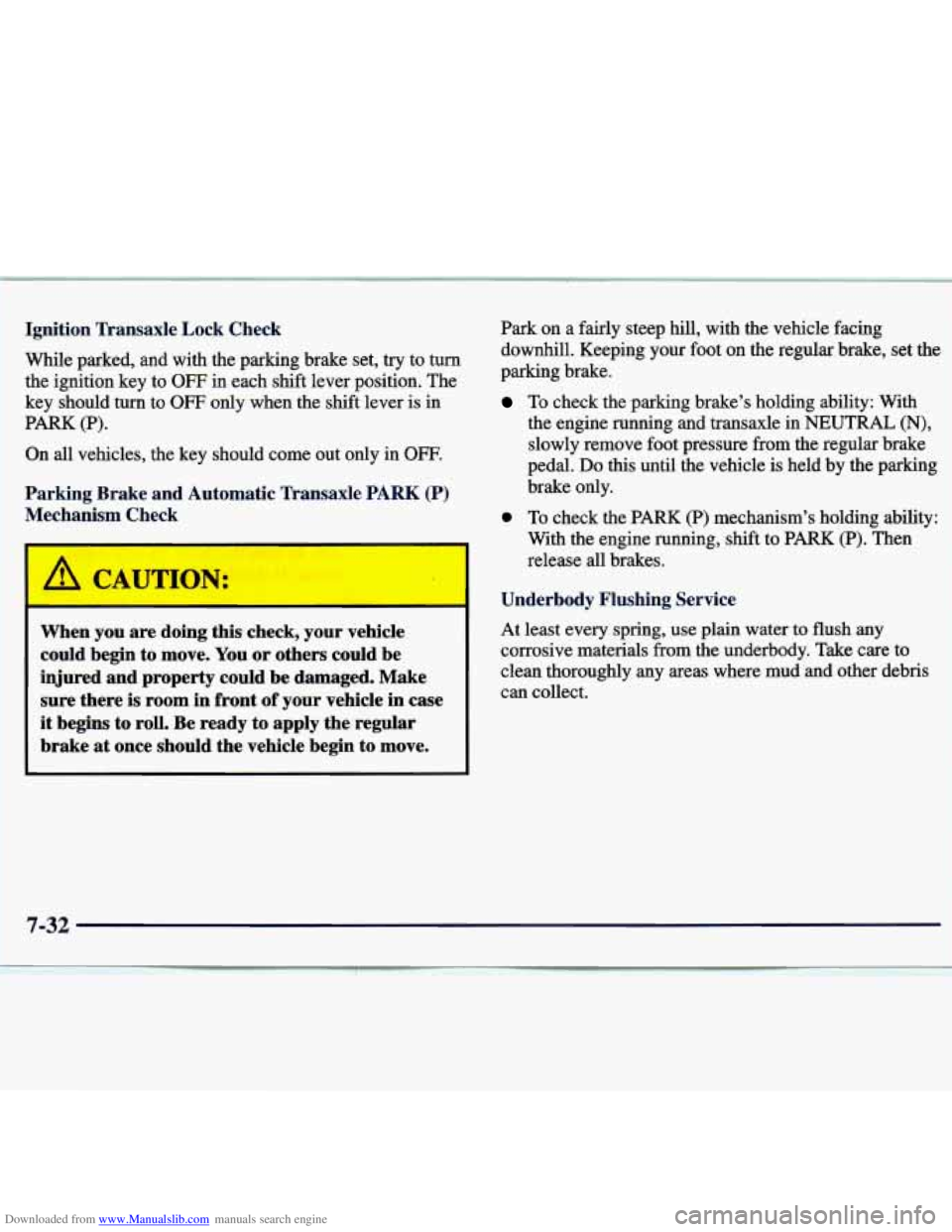
Downloaded from www.Manualslib.com manuals search engine Ignition Transaxle Lock Check
While parked, and with the parking brake set,
try to tum
the ignition key to OFF in each shift lever position. The
key should
turn to OFF only when the shift lever is in
PARK (P).
On all vehicles, the key should come out only in OFF.
Parking Brake and Automatic Transaxle PARK (P)
T - lanism Check
II
When you are doing this check, your vehicle
could begin to move. You
or others could be
injured and property could be damaged. Make
sure there
is room in front of your vehicle in case
it begins to roll. Be ready to apply the regular
brake
at once should the vehicle begin to move. Park
on a fairly steep
hill, with the vehicle facing
downhill. Keeping your foot on the regular brake, set the
parking brake.
To check the parking brake’s holding ability: With
the engine running and transaxle in
NEUTRAL (N),
slowly remove foot pressure from the regular brake
pedal.
Do this until the vehicle is held by the parking
brake only.
0 To check the PARK (P) mechanism’s holding ability:
With the engine running, shift to PARK
(P). Then
release
all brakes.
Underbody Flushing Service
At least
every spring, use plain water to flush any
corrosive materials from the underbody. Take care to
clean thoroughly any areas where mud and other debris
can collect.
7-32
Page 324 of 362
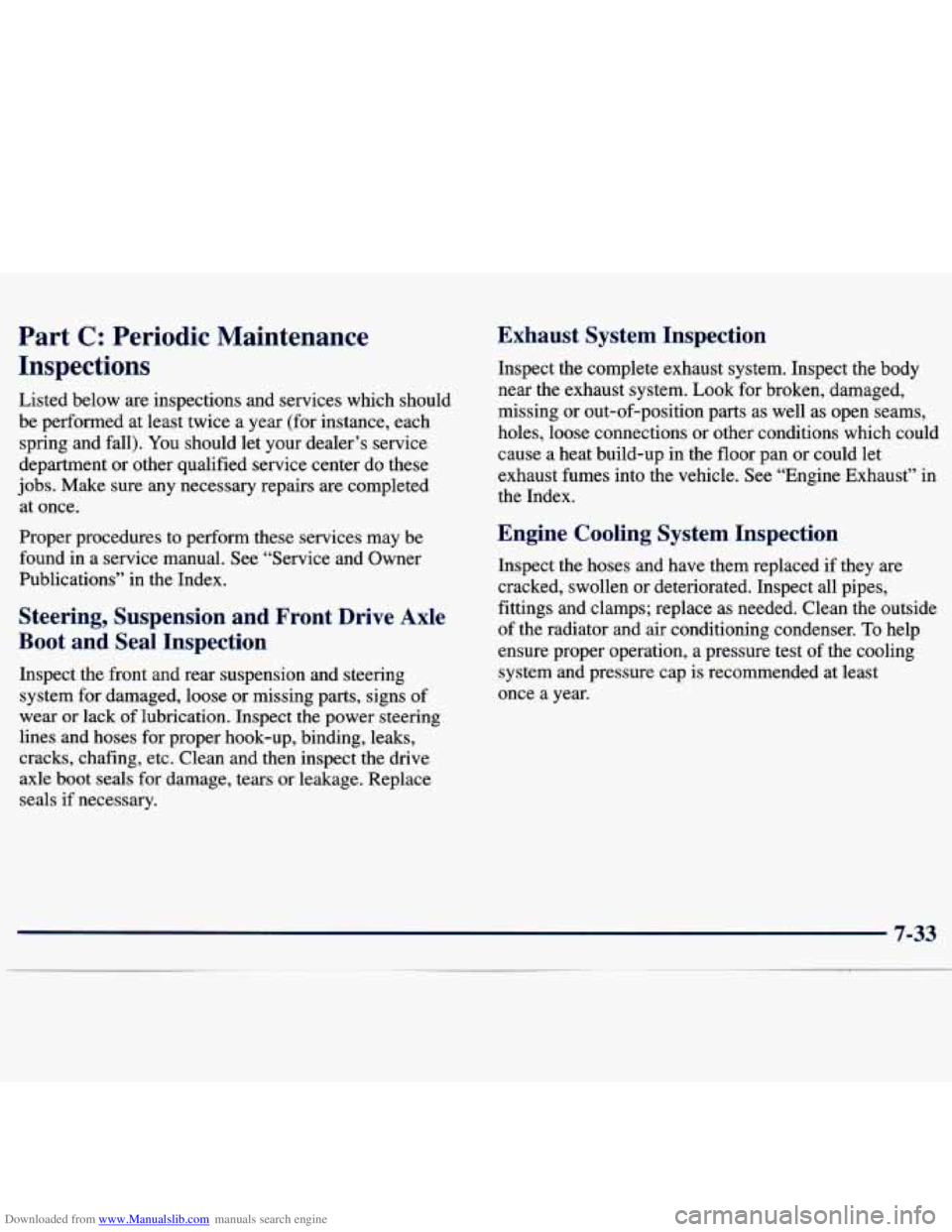
Downloaded from www.Manualslib.com manuals search engine Part C: Periodic Maintenance
Inspections
Listed below are inspections and services which should
be performed at least twice a year (for instance, each
spring and fall). You should let your dealer’s service
department or other qualified service center do these
jobs. Make sure any necessary repairs are completed
at once.
Proper procedures to perform these services may be
found in a service manual. See “Service and Owner
Publications” in the Index.
Steering, Suspension and Front Drive Axle
Boot and Seal Inspection
Inspect the front and rear suspension and steering
system for damaged, loose or missing parts, signs of
wear or lack
of lubrication. Inspect the power steering
lines and hoses for proper hook-up, binding, leaks,
cracks, chafing, etc. Clean and then inspect the drive
axle boot seals
for damage, tears or leakage. Replace
seals if necessary.
Exhaust System Inspection
Inspect the complete exhaust system. Inspect the body
near the exhaust system. Look for broken, damaged,
missing or out-of-position parts as well as open seams,
holes, loose connections or other conditions which could
cause a heat build-up in the floor pan or could let
exhaust fumes into the vehicle. See “Engine Exhaust”
in
the Index.
Engine Cooling System Inspection
Inspect the hoses and have them replaced if they are
cracked, swollen or deteriorated. Inspect all pipes,
fittings and clamps; replace as needed. Clean the outside
of the radiator and air conditioning condenser.
To help
ensure proper operation, a pressure test of the cooling
system and pressure cap
is recommended at least
once a year.
Page 325 of 362
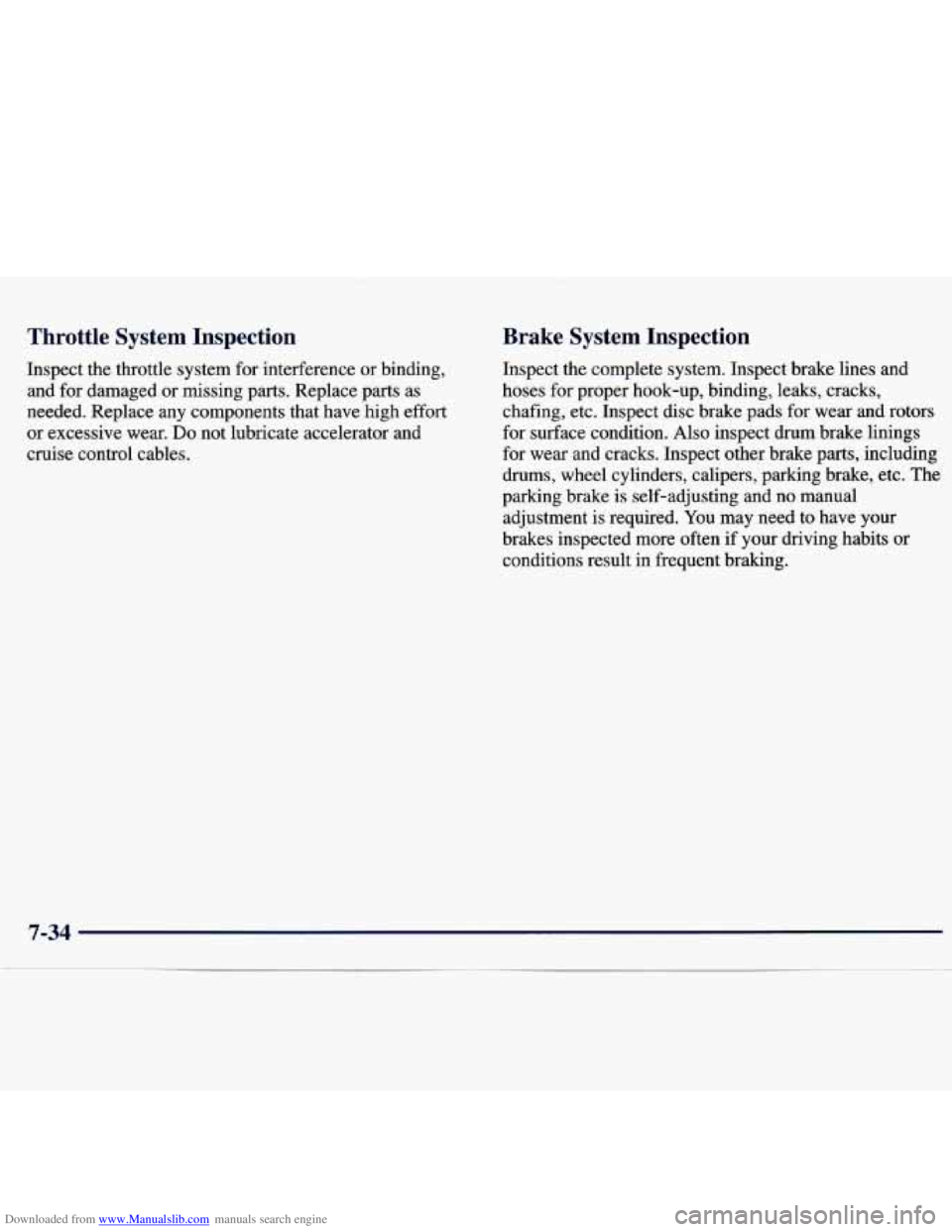
Downloaded from www.Manualslib.com manuals search engine Throttle System Inspection
Inspect the throttle system for interference or binding,
and for damaged or missing parts. Replace parts as
needed. Replace any components that have high effort
or excessive wear.
Do not lubricate accelerator and
cruise control cables.
Brake System Inspection
Inspect the complete system. Inspect brake lines and
hoses for proper hook-up, binding, leaks, cracks,
chafing, etc. Inspect disc brake pads for wear and rotors
for surface condition. Also inspect drum brake linings
for wear and cracks. Inspect other brake parts, including
drums, wheel cylinders, calipers, parking brake, etc. The
parking brake is self-adjusting and no manual
adjustment is required. You may need
to have your
brakes inspected more often if your driving habits
or
conditions result in frequent braking.
Page 326 of 362
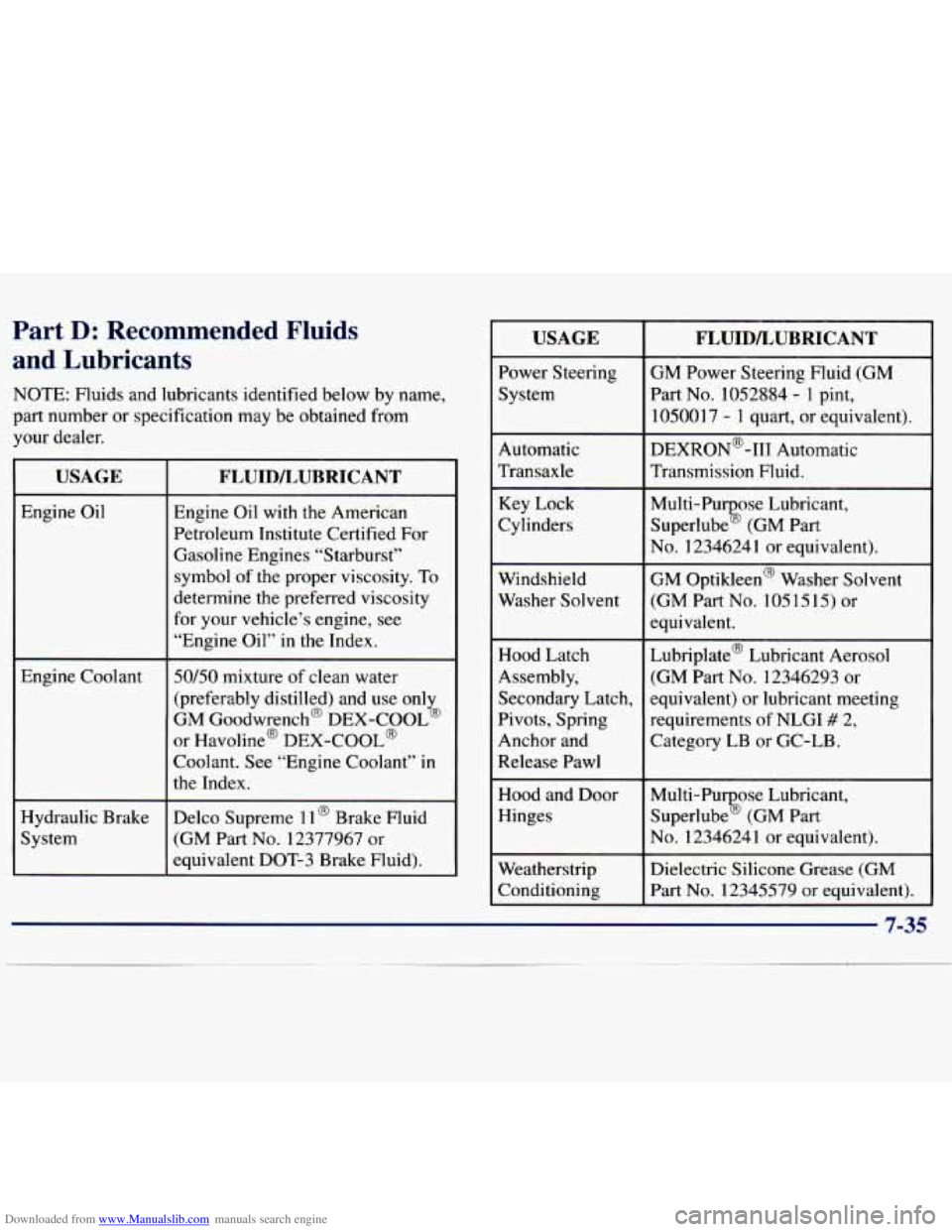
Downloaded from www.Manualslib.com manuals search engine Part D: Recommended Fluids
and Lubricants
NOTE: Fluids and lubricants identified below by name,
part number or specification may be obtained from
your dealer.
USAGE
Engine Oil
Engine Coolant
Hydraulic Brake System
FLUIDLUBRICANT
Engine Oil with the American
Petroleum Institute Certified For
Gasoline Engines “Starburst”
symbol of the proper viscosity.
To
determine the preferred viscosity
for your vehicle’s engine, see “Engine Oil” in the Index.
50/50 mixture of clean water
(preferably distilled) and use only
GM Goodwrench@ DEX-COOL@
or Havoline’ DEX-COOL@
Coolant. See “Engine Coolant”
in
the Index.
Delco Supreme
11 @ Brake Fluid
(GM Part
No. 12377967 or
equivalent DOT-3 Brake Fluid).
USAGE
Power Steering
System
Automatic
Transaxle
Key Lock
Cylinders
Windshield
Washer Solvent
Hood Latch
Assembly, Secondary Latch,
Pivots, Spring
Anchor and
Release Pawl
Hood and Door
Hinges
Weatherstrip Conditioning
FLUIDLUBRICANT
GM Power Steering Fluid (GM
Part No. 1052884
- 1 pint,
105001
7 - 1 quart, or equivalent).
DEXRON@-IIT Automatic
Transmission Fluid.
Multi-Pu ose Lubricant,
Superlube
% (GM Part
No. 12346241 or equivalent).
GM Optikleen@ Washer Solvent
(GM Part No. 1051515) or
equivalent.
Lubriplate@ Lubricant Aerosol
(GM Part
No. 12346293 or
equivalent) or lubricant meeting
requirements of
NLGI # 2,
Category LB or GC-LB.
Multi-Pu ose Lubricant, Superlube
% (GM Part
No. 12346241 or equivalent).
Dielectric Silicone Grease
(GM
Part No. 12345579 or equivalent).
7-35
Page 327 of 362
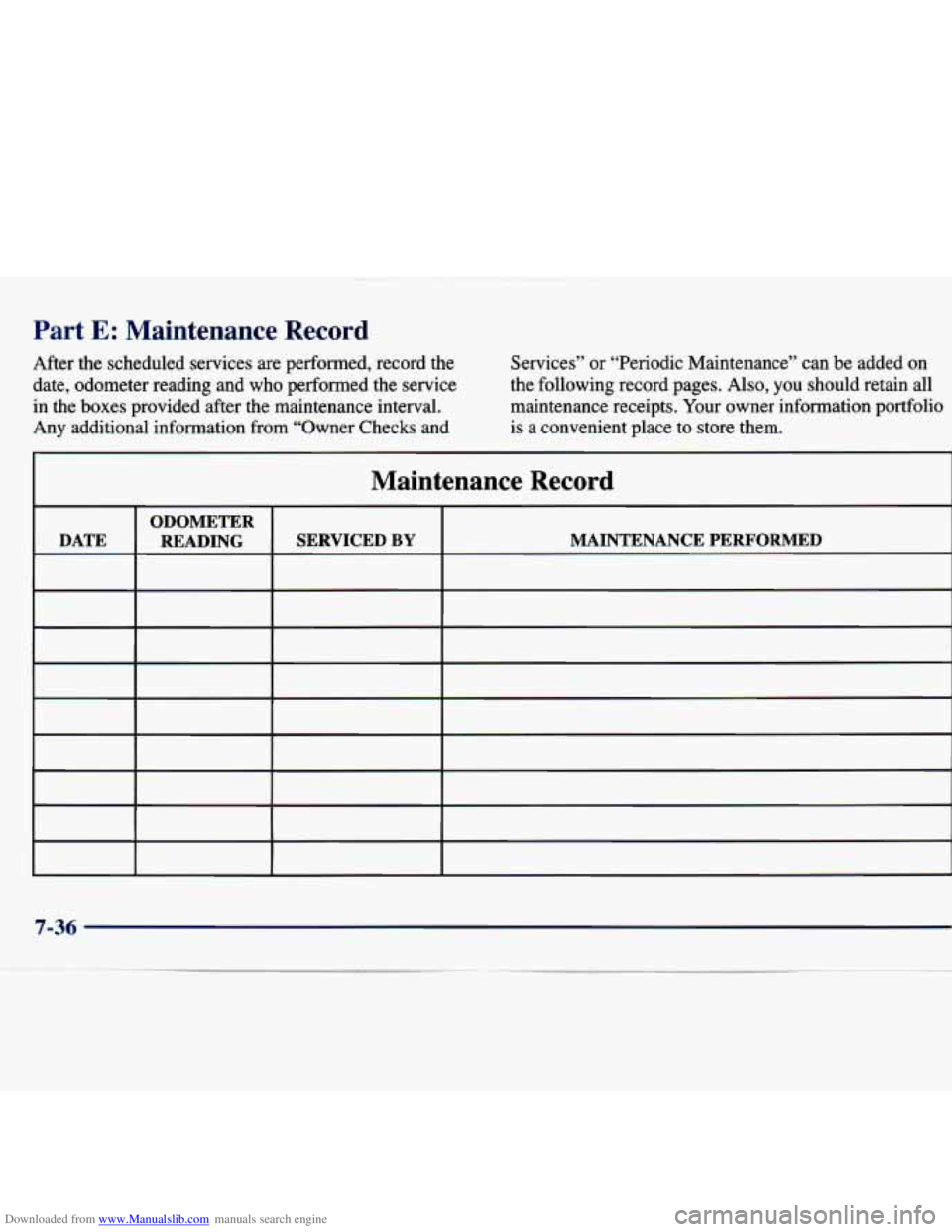
Downloaded from www.Manualslib.com manuals search engine Part E: Maintenance Record
After the scheduled services are performed, record the date, odometer reading and who performed the service
in the boxes provided after the maintenance interval.
Any additional information from “Owner Checks and Services” or “Periodic Maintenance” can be added on
the following record pages. Also,
you should retain all
maintenance receipts. Your owner information portfolio
is
a convenient place to store them.
Maintenance Record
ODOMETER
READING MAINTENANCE PERFORMED
SERVICED
BY
I
7-36
Page 328 of 362
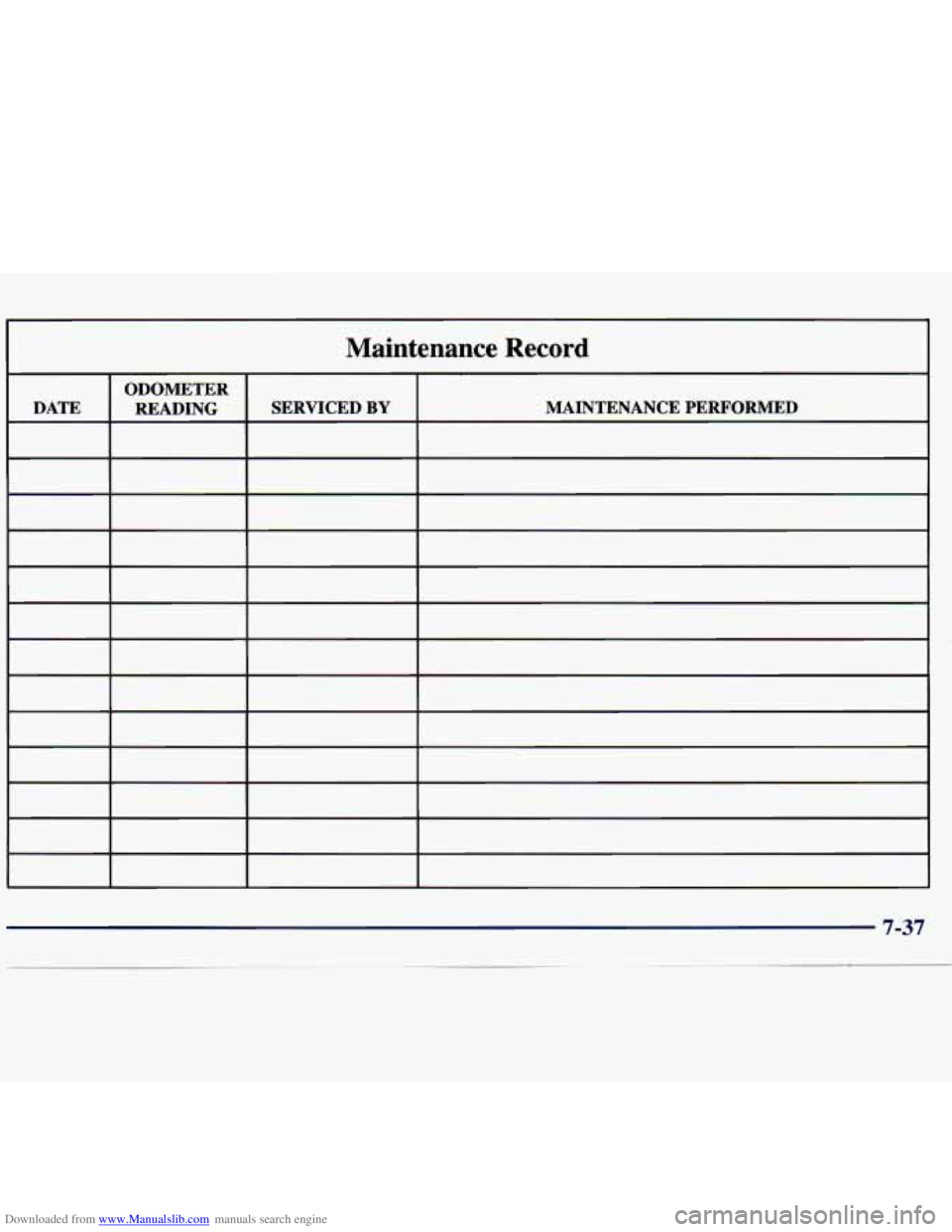
Downloaded from www.Manualslib.com manuals search engine Maintenance Record
ODOMETER
DATE MAINTENANCE PERFORMED
SERVICED
BY READING
~
Page 329 of 362
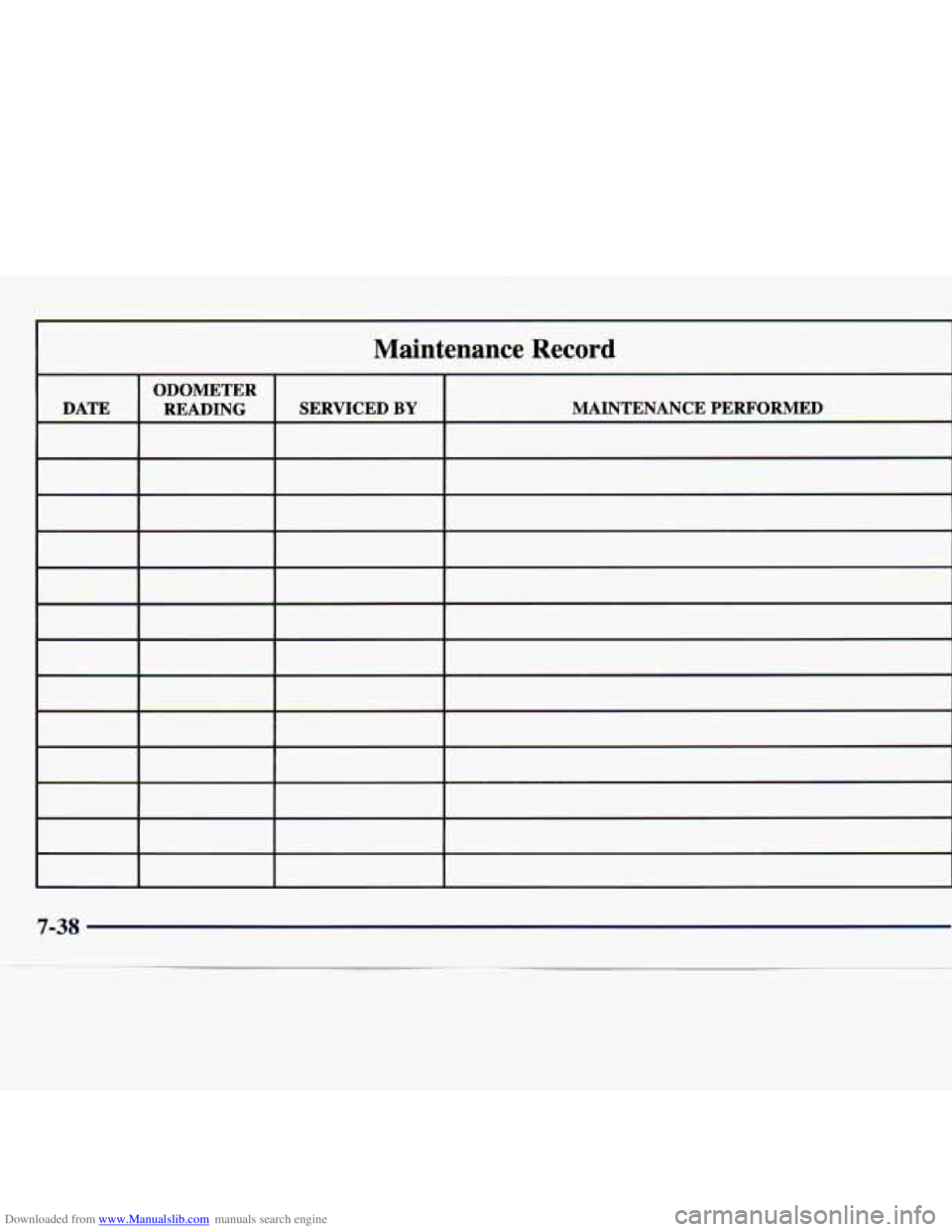
Downloaded from www.Manualslib.com manuals search engine I
Maintenance Record
7-38
Page 330 of 362
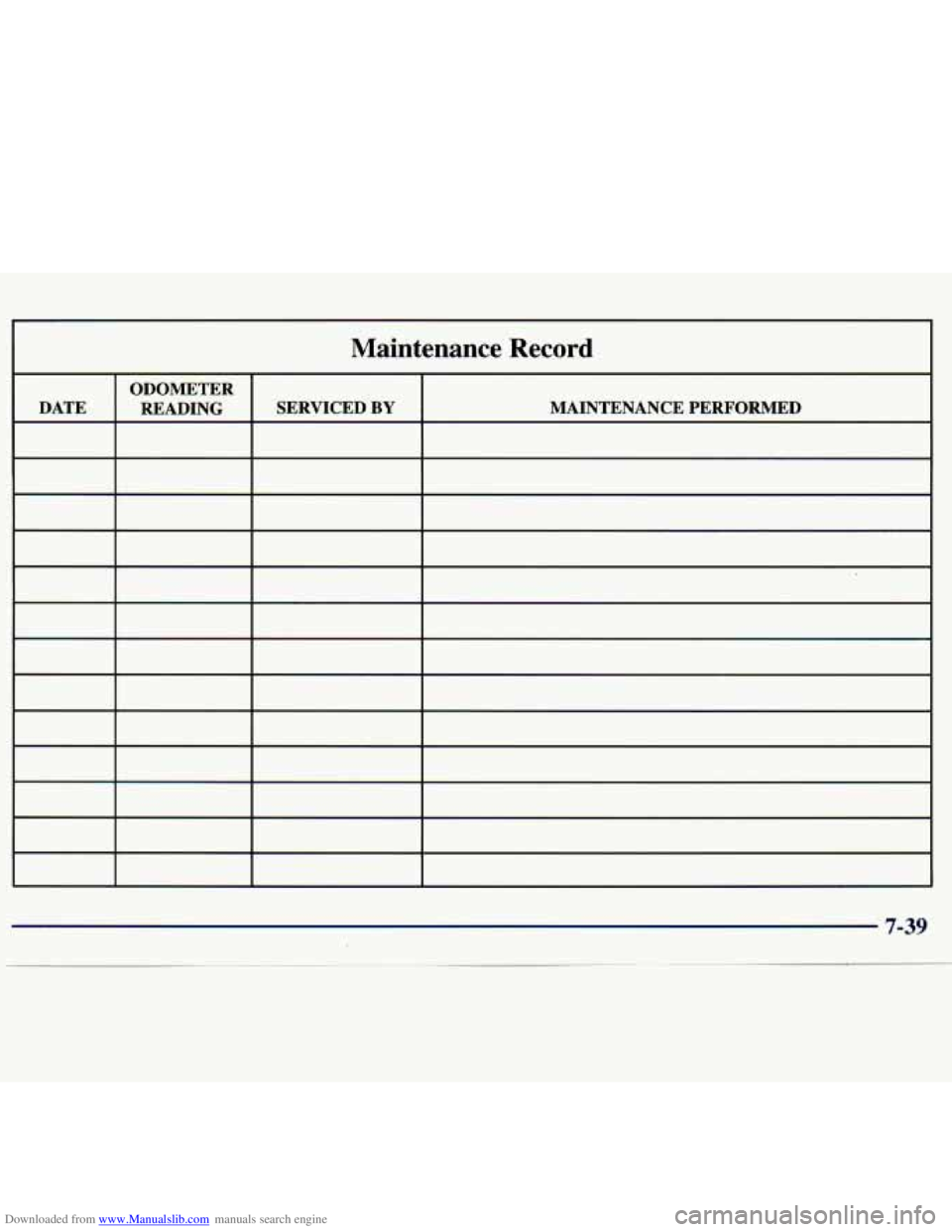
Downloaded from www.Manualslib.com manuals search engine Maintenance Record